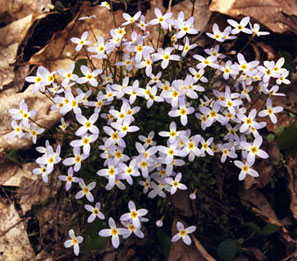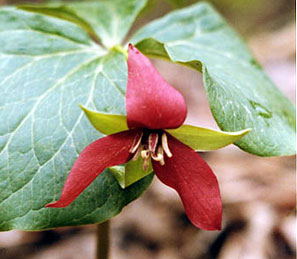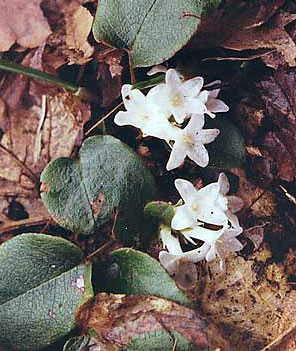Views from High Acres and Beyond
by Roger Russell
This page is copyrighted
No portion of this site may be reproduced in whole or in part
without written permission of the author.
The Woods
![]()
As we get older and our bodies run slower, time appears to run faster. Yet, in our younger days, as we hurried by, there seemed to be no time to stop and appreciate all that surrounds us. There were other interests that were more important. Now that time seems to slip by faster we may realize that we have missed something essential. Now, if we can take the time to stop and experience our surroundings, it is almost like appreciating things for the first time as if we never saw them before. I had not anticipated writing about my encounters but the happy memories are so strong I decided to set them down as best as I can. Words and pictures are not enough to convey the total sense of what it would be like if you were actually there but perhaps they will be adequate to convey some meaning with them. These are only a few of the hundreds of color, black & white and stereo pictures I took over the years. I have provided a map of the woods at the end of this story so that you can refer to the numbered ( ) locations that I mention in the text. However, the story continues beyond the area covered by the map.
Discovery
I came across the woods one noontime, a few days after the speaker lab was relocated to a smaller building in front of the main plant. Before then, I was used to spending noon times behind Plant 5 in Hillcrest where no one went and then way across the field to the Chenango River—but that is another story. I needed a new place to escape to at noon. I could cross Conklin Avenue and the railroad tracks to the Susquehanna River but it wasn't very private and a train was sometimes stopped, blocking the way. The area on the other side of the tracks was used as a dump. A little further on was Sandy Beach where people sometimes parked at noon.
An alternate was to walk uphill on Felters Road. It went uphill for over a mile. It was too much to walk to the top of the hill. There were no sidewalks after a ways and there were often cars that went speeding by, so part way up I turned off at a place where I could enter some woods without walking across anyone's yard. I became isolated in a different world hidden by trees. There is a creek and a ravine. It is the same creek that runs past plant 4, where I work, and then down to the Susquehanna River.
The hill in the woods rises steeply from the creek. There is an uphill path from the creek to what I later called the lower path (19). This path runs the entire length of the woods. The first time I went into the woods, I could only make it to the lower path. I was not used to so much hill climbing but I really did love to climb hills. So as the days and weeks went by, I gradually grow stronger and explore further into the woods, learning many secrets that it contains.
Who would have thought that soon after discovering these woods, I would find it was for sale and was able to actually buy this property for only $4500 and pay only $32 in yearly taxes. After examining a tax map, I learn that this woods was part of an area called High Acres. It appears that back in the thirties, the property had been part of a proposed development, but nothing had been done with it. It had apparently been purchased on speculation by a builder in the hope that it would someday develop like the area on the other side of Felters road. All 11.6 acres are completely covered with trees. Some are quite young and others, like the oaks and hemlocks, may have been there for 100 years.
I realize the land is not really mine. Oh, I have title to it. I own it by law recognized by some, but it isn't really mine. I can’t keep anyone or anything in or out. It is too big and is really a waste of time to even try. What would be the point? I use posted signs around the perimeter more for the legal aspect than to keep people out. The birds, animals and insects and weather know no boundaries.
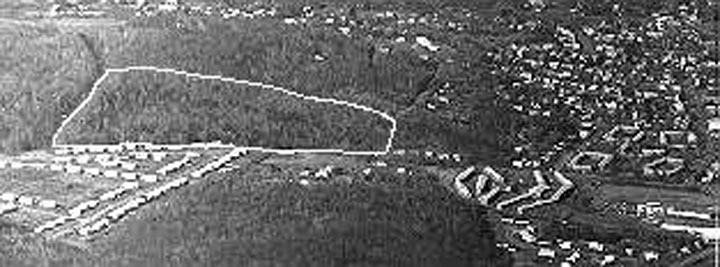
I took this picture from a chartered plane when we were flying to New Jersey to visit United Speaker Systems. McIntosh is in the lower right corner. The white line in the picture encloses the property. Felters Road continues horizontally across the picture. The bottom part of the woods can't be seen from this angle because the development at the left is on the near side of Felters Road and is very high.
On the left side of the property the trees are cut away. That is where the power line runs up a very steep hill and then turns slightly to the left. This is the southern border. The upper property line runs from the power lines through the trees to the right side. That's the northern end at the corner of Harding Road and Overland Drive (23).
Then follow the line straight down to the left house in the group of five houses on the far side of Felters Road. The creek flows to the right and goes through a large pipe under Felters Road at that corner (22). Then, follow the bottom line to the left back to the power lines. That's where the property line is defined by the creek for about 2100 feet. The creek is about 300 feet from Felters road at the power lines.

I can see the hill each morning when I park my car next to plant 4 at McIntosh. My woods covers the left portion of the hill right up to the top. In the winter, when it is dark at 5:00 PM and when I am about to leave in the car, I can look up and see if the street light is on at the corner of Harding and Overland (23), near the corner of the property.

Other mornings, when there is snow blowing in the air, I can hardly see the hill at all. On a day like this, it is a good time to go for a walk in the woods. I go there almost every noontime, summer or winter, rain, snow or sunshine.
The Entrance
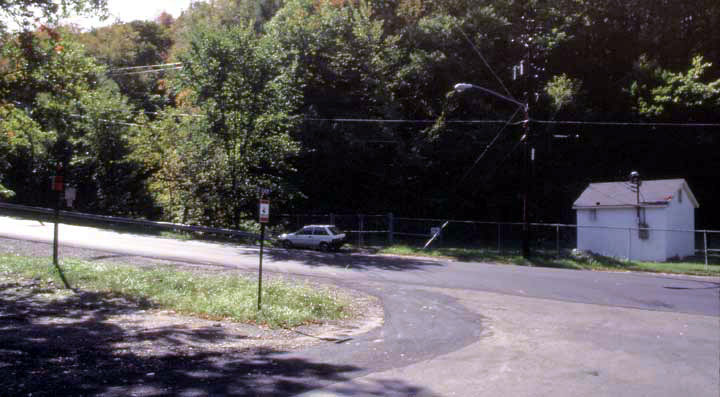
I walk uphill on Felters road to the woods, just past where the five houses are. This picture is the area where I usually enter the woods. It is at the bottom of St. Clair Road where it meets Felters Road (22). There is a pump station and a fence that may be associated with the development higher up on the hill. The creek goes under Felters Road at the further side about where my car is parked and emerges down the road on this side off to the right.
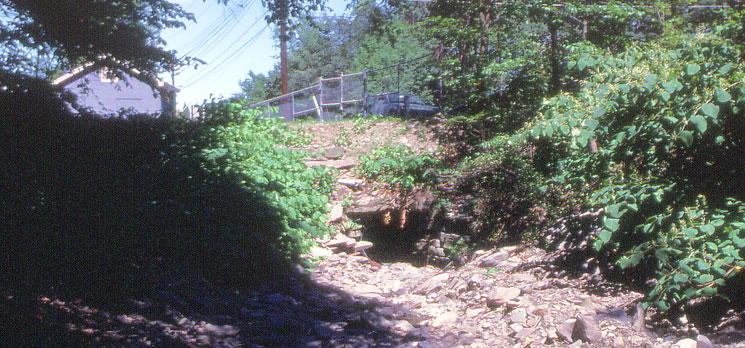
I can go around the end of the fence and above the large round pipe where the creek flows under the road. The concrete pipe is about four feet in diameter. That is the dark area at the center of the picture. After descending to the creek, I can look back and see the pump house and fence. From this area, I can go up to the creek path (25) and then a short path that leads to the lower path (19). I completely disappear into the magic of the trees. Then, all of a sudden, I realize that no one can see me from the street and no one can find me. This is my great escape for the day. I am in another world totally different from work. It is away from everything, including phones and people. A few times, if I am not feeling as strong or if time is short, I drive up and leave the car by the fence. I almost always take a camera. There is always something new to photograph, perhaps because of different light or a new way of seeing things.
Locating the Woods

I often wondered exactly where the woods was when looking up from where I park at the lab. I had even thought of somehow raising some kind of marker or flag so I would have a reference point. It turned out that nature provides the means. One morning, when I arrive at work, I notice there is only one remaining tree with yellow leaves on the entire hill. I am certain this must be something that I can find. All the other leaves had fallen. In the picture above, the lower yellow building is the addition on the side of the main plant. Above this are the Saratoga Apartments and above that are the woods.
|
|
|
At noon time, I go up to find the tree. By then, the clouds have cleared off and given way to a deep blue sky. I am able to find it (5). There it is, near the top and close to the unworn steep path (27) that I use to get to the top of the hill. The dogwoods are not far from it. I can lie on my back in the leaves with my trusty Nikon camera and take pictures of it. Then, I know for certain where the property is with respect to the view from where I park.
The Fall
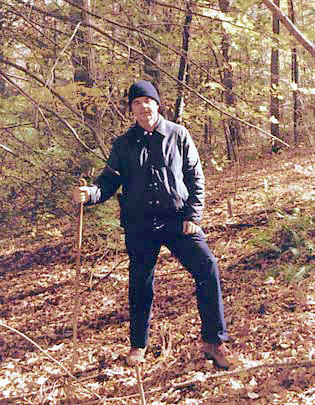
It is most enjoyable in the sunny, fall afternoons after some of the leaves have fallen and turned brown. It is cool then but the sun warms me and I have a ski hat to keep my head warm. The sun stays low in the hazy sky and casts long shadows on the ground. It is like the whole day is one long afternoon. It is at a time like this when such an experience can be etched forever in memory. It is when all of the senses seem to be tuned to maximum and awareness is at its peak. It is so quiet and peaceful. There is usually no wind. I can see much further through the trees when the leaves are gone. The only sound I can hear is from my own footsteps on the dry leaves or sometimes from a squirrel burying something in the ground and covering it with leaves. The smell of the woods is different in the fall—maybe of acorns or some such thing. The only color of green that is left is in the hemlocks and the hundreds of ferns that seem to be greener than ever before.
Who took the picture? Actually, there was no one. I bought a clamp that fits on a small tree. It has a threaded piece that screws into the camera base and I can tilt the camera to be level. By using the self-timer on the camera, I have ten seconds to make it back to where I should be for the picture. I wear hiking shoes with a deep tread. I think this may have helped avoid any slips in climbing or descending the hill. I always carry a walking stick or two. I keep them at the entrance to the woods so I can find them easily on my next adventure.
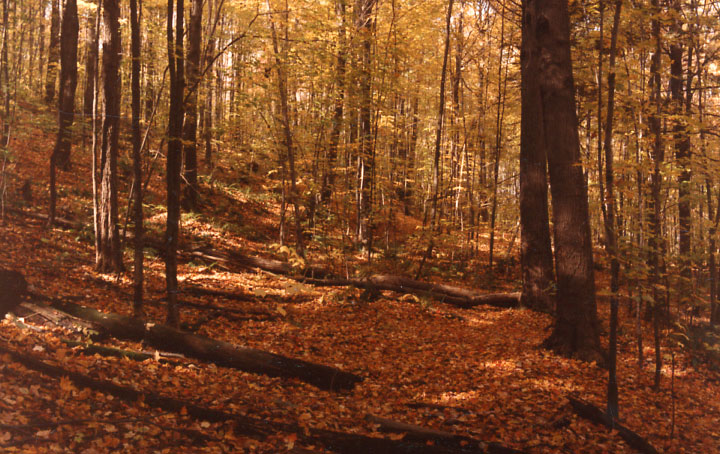
In pleasant and lingering fall afternoons of long shadows, the light is tinted from the haze and leaves that have turned color. I call these “golden afternoons.” Perhaps a golden color is reminiscent of a warm camp fire or fireplace—something we are inherently conditioned to associate with warmth, well being and food. As I walk deeper into the woods, The color becomes more pronounced.
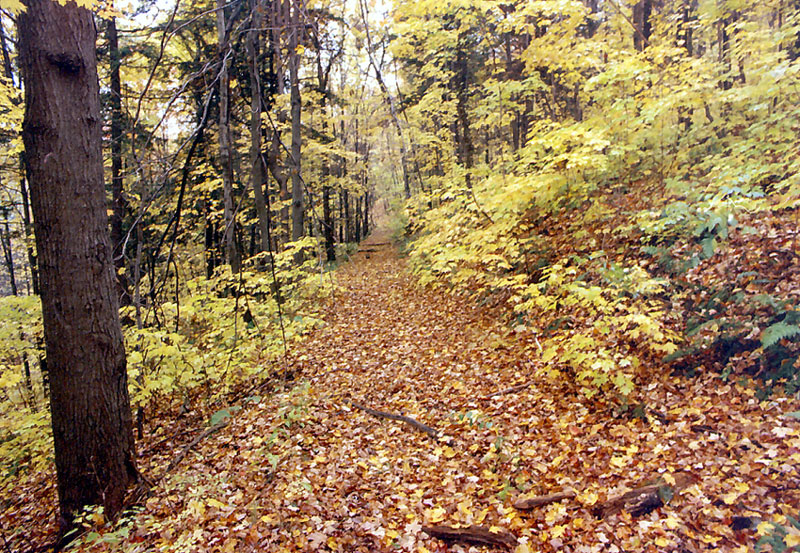
The lower path (19), looking south, may have been an old logging road. It runs the length of the property. It is fairly narrow in some places and not too good for a motor vehicle. However, at the time when there used to be a house at the north end (21), it may have been used by horses and a cart. There is also a small dump on the left side of the path that is hidden in the brush. It contains only a few pieces of old glass and rusted cans. The lower path becomes covered with leaves in the fall. Even the ferns are initially covered.
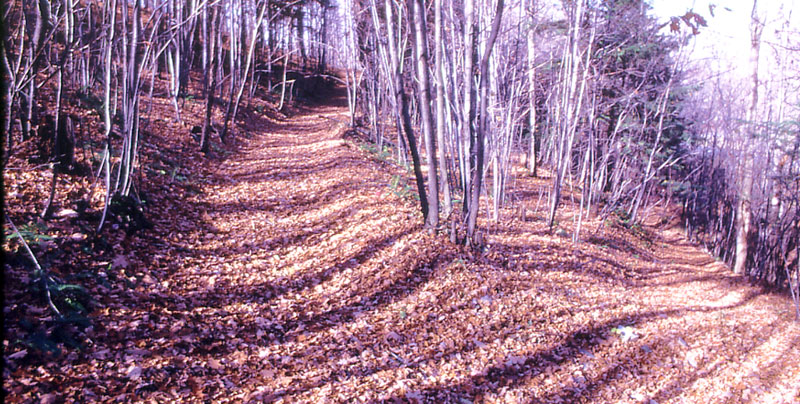
This view is looking to the north. The path at the left I call the lower path and leads up to the further corner marker (3) of the woods and Harding Avenue. The path at the right leads down to the creek (25). After reading this, Ken, my friend and high school classmate suggested the following poem that he had memorized to recited in English class.
The
Road Not Taken
by Robert Frost
|
Two roads diverged in a yellow wood, Then took the other, as just as fair And both that morning equally lay I shall be telling this with a sigh |
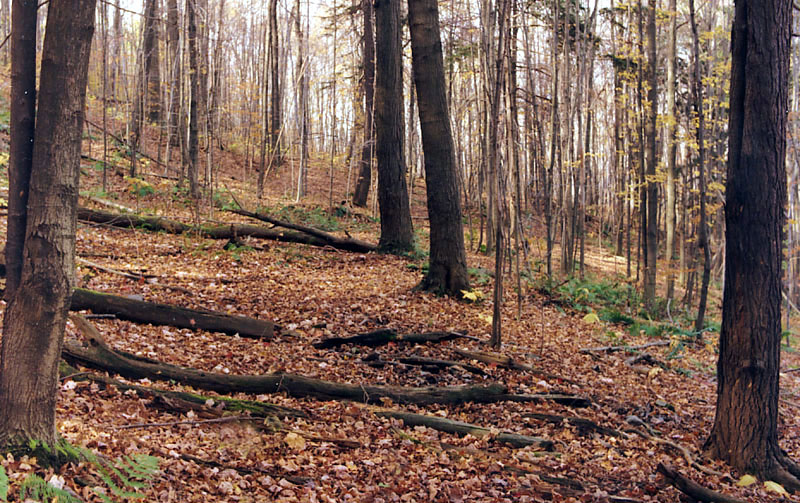
This view is looking north along the upper path (24) that eventually merges with the lower path near the large Beech tree (14). It isn’t really a path but is just sort of a flat area. There was an old rusted mattress spring lying along here. I dragged it out of the woods and put it near the end of Harding Avenue (23) with some other trash someone had put there. I call this area the camp site because it looks like someone might have used it at one time.
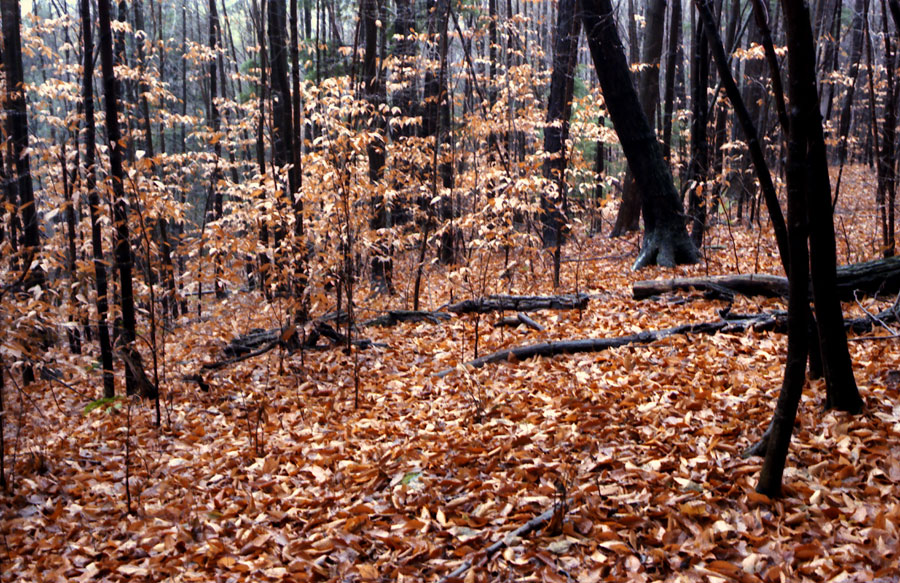
The changing light and different locations provide an almost endless number of interesting pictures. Here, it is like a strong light is shining only from directly above and nowhere else. Each day I find something new to photograph. A rule in photography is to keep a camera with you whenever possible and take pictures right away when you see them. If you wait or come back later the unique conditions of lighting can change and the impact of what you saw is lost and may never be the same again.
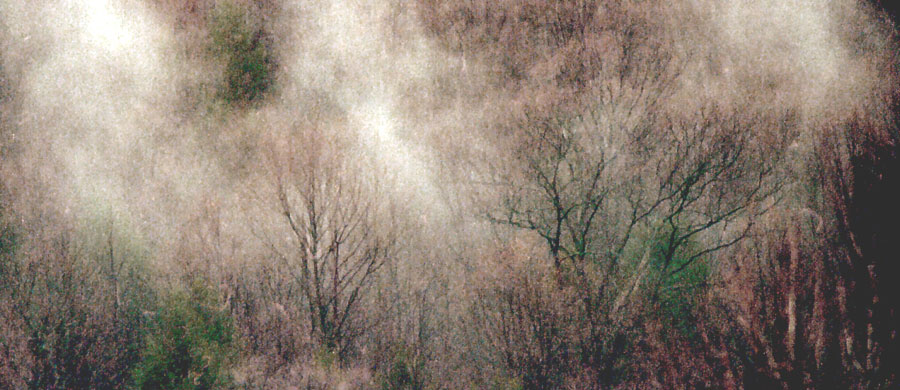
Sometimes, under the right conditions of temperature and humidity, mist can appear rising seemingly from nowhere out of the ground. It slowly rises and changes shape perhaps from slight air currents. It brings back memories of the movie Fantasia where the spirits rise from the graves to be tormented. It is accompanied by Mussorgsky’s A Night on Bald Mountain. Although there are no leaves on the trees, some green areas can be seen, probably from ferns that remain green for a while.
While I have seen such mist on my High Acres hill, this is a better picture from the woods behind my house in Conklin. One day I notice that the top of High Acres is enveloped in fog. Here is yet another experience this time to find out what it is like to be up there in a fog-covered hill. When there, it is like any foggy day but there is no fog below me and that is unusual. I have not only escaped into the woods but am hidden by fog as well.
![]()
Night Walking
Have you ever tried walking in the woods in the dark, where you can only see the faintly lit sky between the trees? In the summer, the leaves block most of the sky so at night you can’t see your hand in front of your face. You have to step carefully to avoid tripping on branches, stones and even getting into spider webs. You could at least feel your way around by using a cane or stick like a blind person does.
But that is not the hard part. It is the imagination that can run wild. Knowing you are alone, too far to call for help, can be a concern but it is the knowledge that bears or other beasts that can see or smell better than you could be lurking or following you. Looking around is obviously no help in the dark and listening for any clues like faint sounds can be a primary concern. Then, what if there is a faint sound or worse, a loud sound?
I tried this, not in these woods because I was only there during the daytime but in another woods behind my house in Conklin. I cheated and carried a flashlight to get way out in the woods and then turned it off. There was no path to follow there. Some of the things that I mentioned earlier happened. So after a few minutes, I turned the flashlight back on.
![]()
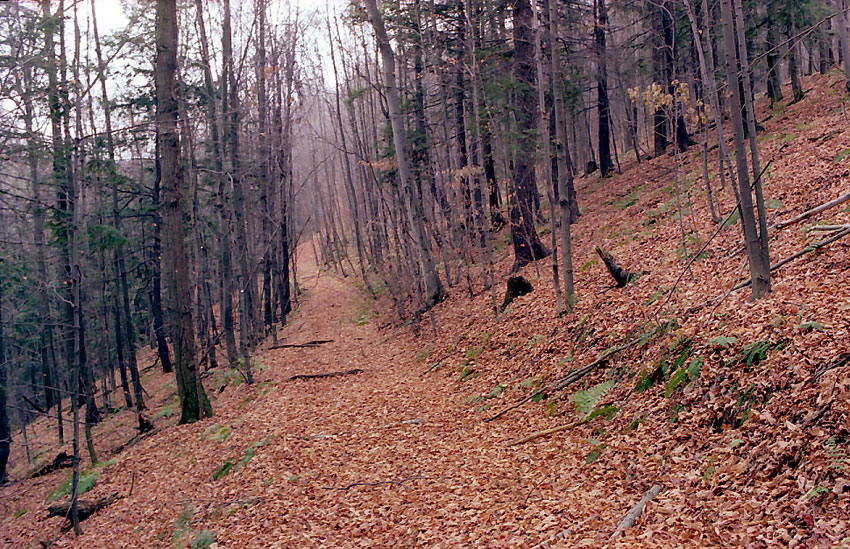
On cold, cloudy days like this, when the temperature is near freezing, I know that winter is near and a cold rain or even snow can come at any time. It is like I am on borrowed time and that soon all that I can see will be covered with snow. This is such a day when one thinks of being inside out of the damp, bone-chilling cold and away from the dark gray sky--but that is for later. This is the time to experience yet another quality of my private woods. I feel warm enough with a well-insulated jacket, ski hat and gloves. This sort of weather is not too cold for me. It is more invigorating.
Sometimes I see a deer in the distance and I stand still to see if it will go on about whatever it was doing. My presence is not a secret. The deer may have already seen me or gotten my scent and the dry leaves had made noise that it could hear. Often, the deer will just snort and trot off. Sometimes I wear an orange ski hat so that I will be seen in case there is a hunter around.
The Snow
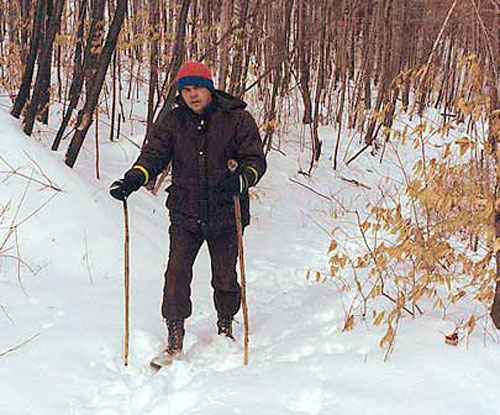
I use two walking sticks when there is snow. It is better exercise and takes some of the burden from my legs. When it is very cold, only 10 or 15 degrees, my fingers get cold and I put them inside my coat for a while to warm them. Later, I buy a pair of mittens where all the fingers are together and this keeps them much warmer. I always weare long underwear on cold days like this. A few times, the snow is higher than my boots and gets inside even though I tuck my pants inside them. I usually follow my footsteps from the previous day to the top as it is easier walking. Coming downhill is usually a lot faster as I can come down a different way each time using the older crusted snow as a brake.
There are sometimes animal tracks in the snow. One time I find the wing imprints of a large bird in the snow, but there are no footprints around them. I guess that an owl had caught a mouse in its talons and then taken off again from the same spot leaving just the wing impressions. Another time I find what might have been fox footprints and an occasional spot of blood in the snow. At first I thought it had been injured, but then I thought perhaps it had been carrying a mouse or something that it had pounced on and killed. It may have been the mouse that was bleeding.
One cold day I followed some human footprints that are not mine, just to see where they go. I follow them up to the lower path and there at the bottom of one of the prints is a rolled up five-dollar bill. So I look around the area for more but that was it. I speculate that the person must have taken something out of their pocket and had forgotten they had a five dollar bill in it. Later, it blew into the hollow of the footprint.
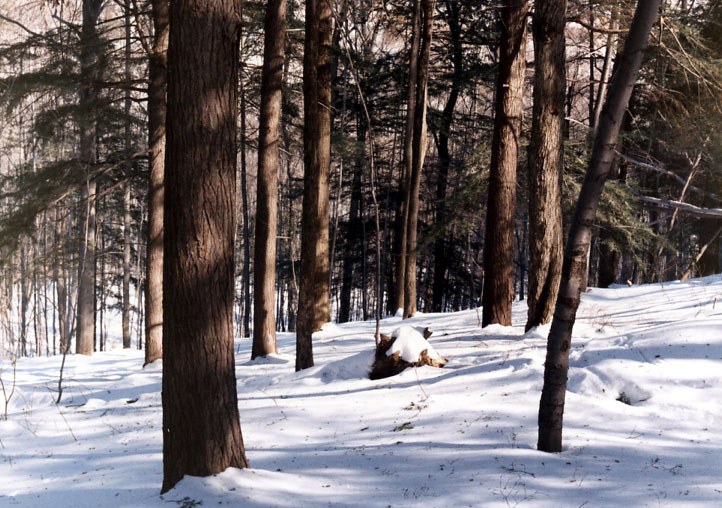
Despite the presence of any snow, I am able to climb up the hills with the aid of my walking sticks. On a sunny afternoon like this, the temperatures can still be well below freezing and the snow does not melt. The coldest weather comes a day or two after a storm front passes through. When conditions are just right, and the temperature up in the hills is lower than in the valleys, the tops of the hills will be white with snow and the lower part will be darker without a white coat.
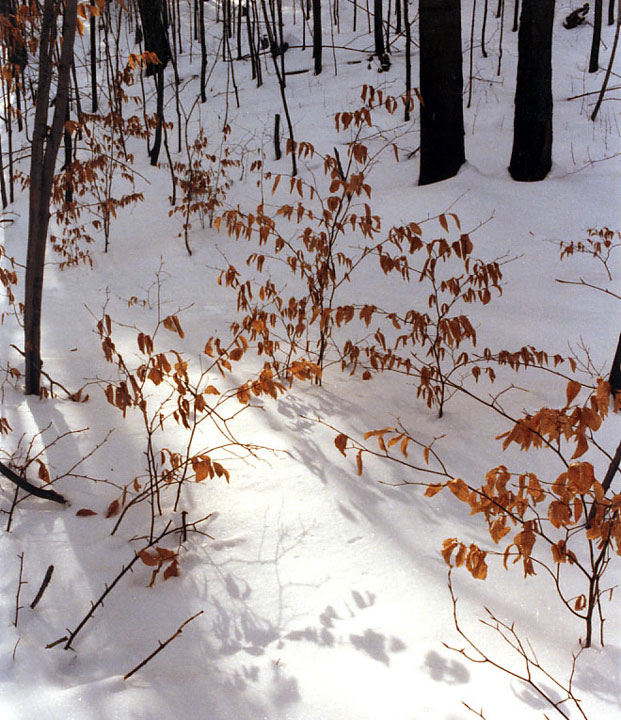
On the side of the hill, the sunlight looks even lower in the sky and casts much longer shadows, even at noontime. Here can be seen the brown leaves retained by the young beech trees (4) along the lower path (19).
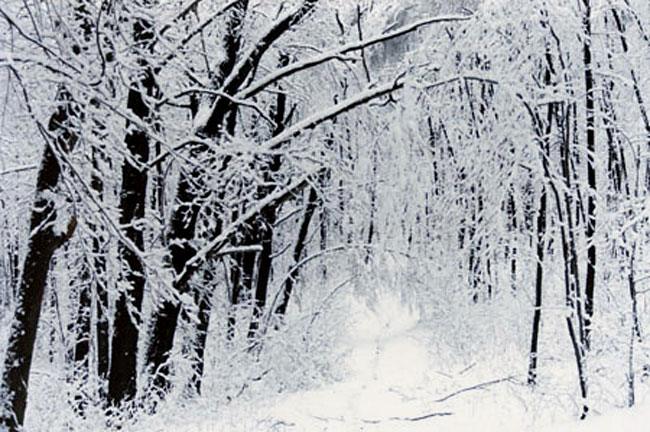
Here is the path that leads from the creek path (25) to the lower path (19). When snow falls, distant sounds are muffled and the air is very still. I liked to walk through the woods when it is actually snowing. The whole area is transformed into an alien world that I rarely get to see. The sky is a dark gray and the woods takes on a completely different cast. The trees are wet and dark and the snow on the trunks and branches have an almost unreal gray color. I cannot see as far when the snow piles up on the branches and I get this very closed-in feeling. Many are bent over from the unusual weight. The snowflakes can be heard hitting my hood that I pull over the ski hat. I keep the camera inside my jacket to keep it dry.
This reminds me of the Robert Frost poem “Stopping by Woods on a Snowy Evening.”
Whose
woods these are I think I know.
His house is in the village though;
He will not see me stopping here
To watch his woods fill up with snow.

In the early winter snowstorms, the snow piles up on the surrounding rocks, branches and sand. The snowstorms are very quiet except for the water at a mini fall. The above black & white picture shows how the creek can be transformed to give an entirely different appearance. The water seems to be very dark and the contrasting snow that covers the stones gives no hint for what might lie beneath.
The Spring
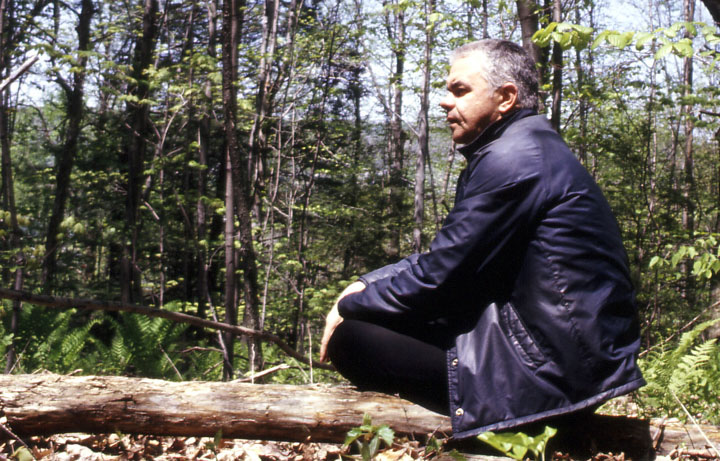
Here is one of those first days in early spring when I don’t need to wear a heavy coat. It is so nice to wear something lighter for a change but not quite warm enough to be without a jacket and the ground is still cold. I stay in the sun for a while to feel warm. It is probably wishful thinking that warm weather is finally here but after long months of snow and cold, I am anxious to feel warm in the woods once again.
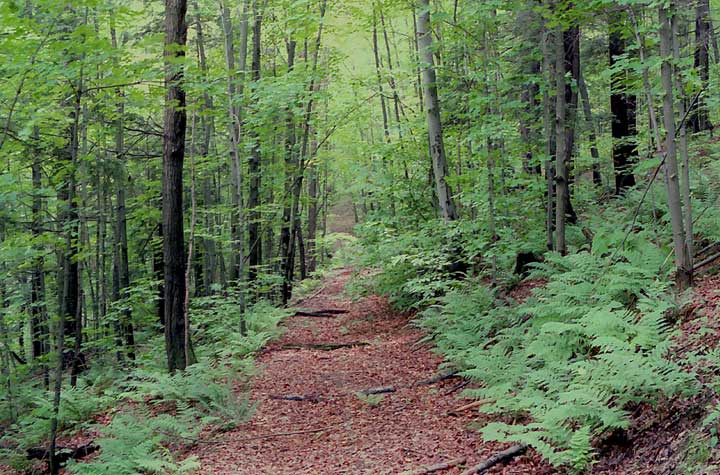
Ferns grow throughout the woods. They are mostly New York and ladder ferns. They line the lower path (19) and spread out under the trees. By springtime, they quickly respond with new fronds. The new tree leaves have that fresh light green color.
Further along the lower path (19), after passing the beginning of the steep path (27)that I usually take to go further uphill, the ground goes down to a lower area (20) that stays wet for some time after it rains or when the snow has melted. Along the way, there is another old but smaller foundation (8) made of flat slate-like stones. It might have been for an ice storage house many years ago. At the end of the lower path (18), is a nice area that could be used for camping. I spend some time sitting there enjoying the surroundings. One day, while I was sitting there, a cat came along the path. I sat still but eventually it saw me and sat down to decide what to do. I still didn’t move but the cat decided to go back down the path.
One other time a dog followed me into the woods. It was sort of like a small hound dog. He seemed to enjoy walking with me and went with me to the top of the hill and back. When I left to return to the lab, I said “go home” and he went off—amazing. I never saw him again.
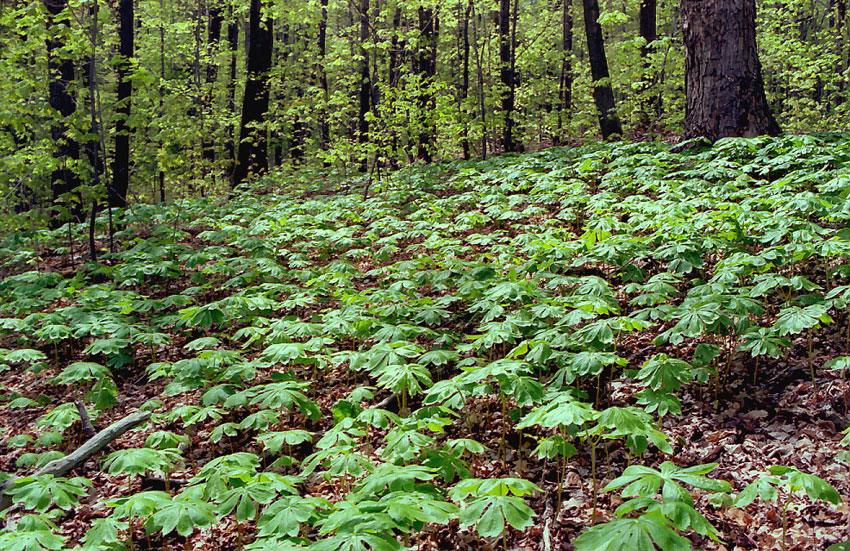
At the north end of the woods (1) some unusual plants come up. I saw this plant for the first time in my explorations at plant 5 and had easily identified it in the wildflower book. They are called Mayapples or Mandrakes. The ground in this small area is covered with their shiny green double leaves. At the center, where the two leaves join, a single white waxy many-petaled flower about 1" in diameter blooms. Later in the year, a single fruit grows and is about 1-1/2" to 2" in diameter. For this picture, I used a polarizing filter to take away some of the shine from the leaves to make a nicer exposure.
For many who pass by a wooded area, the details go unobserved. I think very few are interested to take the time to see and experience what is really there. It is either taken for granted or of no interest. I prefer to view all of what I experience here as something that might be seen for the very last time and do not want to miss anything.
|
Bluets |
Trilium |
|
|
|
|
Mayflower |
NY fern |
In the spring many flowers appear. A May flower, also known as Trailing Arbutus, is a rare find. These are at the top of the hill just beyond the property. They are hard to see as they are often hidden under the leaves. I had to move some leaves for this picture. They are also, an endangered species. The smell is very attractive. Many years ago when my parents and I we were visiting my mother's parents in New Hampshire, my mother and I used to pick them and bring them home. The Triliums are named to account for the tri-group of petals and green leaves. Although some have white petals, all of the ones I found are red.
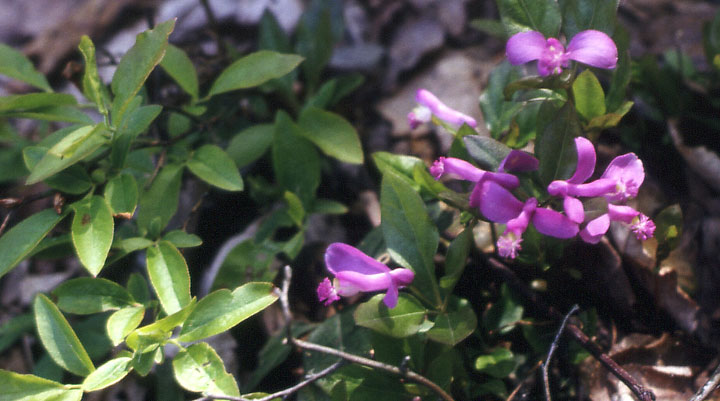
At the top of the hill, I found an unusual flower that took a little while to find in a wildflower book. These are called gaywings and only bloom in the spring.
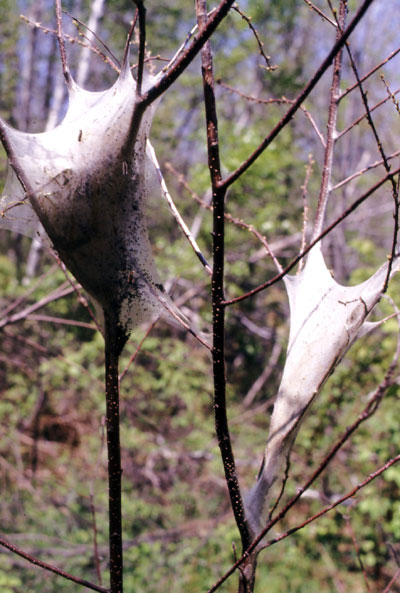
Some years, the tent caterpillars become widespread to the point that they strip the leaves on any tree. The caterpillars can hide in the tent at times to avoid predators. I am lucky to have only a little damage to my woods but other areas are not so fortunate. In looking at the hill tops around Binghamton, the trees are brown and are stripped of all their leaves. It is said that when a tree is attacked like this, the tree releases a chemical that is harmful to the caterpillars and can even cause them to die. Because there are so many caterpillars, I can hear the constant sound of their droppings hitting the leaves below. Later, they turn into gypsy moths.
Other pests are the deer flies. They are the same size as a house fly but with more distinct markings on the eyes, body and wings. There is usually only one and it likes to buzz around my head and get on the back of my neck and bite. I usually find a short twig with many little branches and swish it around my head for a while. Eventually, I will hit it and knock it down or drive it away.
Then there are the gnats that try to get onto my eyes. There will be a cloud of them around me. I find that if I put my ski hat on a stick 2 or 3 feet long and hold it above my head, they will all go up to my hat and leave me alone.
The North-West End

This path is on the border of the woods on the north side (26). This is a view looking downhill. The path leads uphill from Harding Road and the lower path. The upper end of this path fades into just trees before it gets to the top of the hill. It is almost like a road and may have also been used as a logging road many years ago by the owners of the Little Acres farm that is mentioned in an old deed.

There is only an old stone foundation remaining at the bottom of the path (21). This may have been where the house was. I found a jack-in-the-pulpit growing inside the foundation. Close to here and just inside my property is another old dump (2). It appears to be covered with weeds and leaves but a few pieces of trash can still be seen. After digging around, I find several brown bottles and rusted items. There are also many pieces of broken glass.
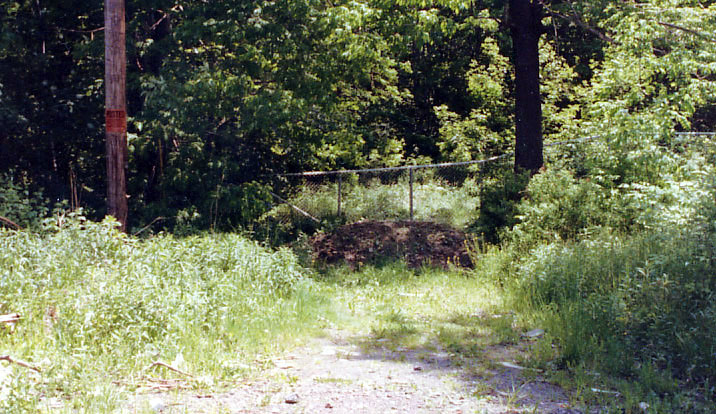
Right next to the old foundation on Harding Avenue is the upper entrance to the woods. Although the tax map shows the road extending to the property, in fact, it was never completed and is only dirt and weeds. However, there is evidence that people had been driving in there. After purchasing the property, I decide to have a chain link fence put up to keep people from driving in and having beer parties, etc. I also have a load of bank run gravel dumped in front of the fence. I put a posted sign on the power pole.
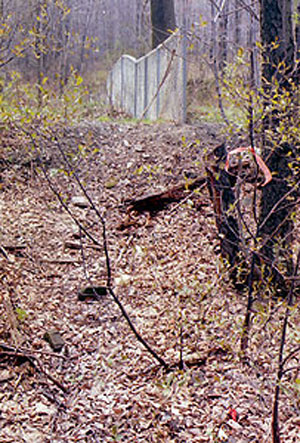 I did not have the land surveyed for the purchase as
it would be very expensive and is not really necessary. Several years later, in
April, 1984, I find only one survey marker and that was near the end of the
fence, about 20 feet behind the power pole in the entrance picture (3). A
closer picture shows the orange ribbon tied to a small tree. The actual marking
stake in the ground is at the bottom right of the picture and has a small red
ribbon tied to it. Knowing this point, I can use a compass and pace to about
where the other corners should be. Of course, the creek, being one boundary, makes
it much easier. One small corner of the property is in the City of Binghamton
and the rest is in the Town of Binghamton. I pay taxes only to the Town.
I did not have the land surveyed for the purchase as
it would be very expensive and is not really necessary. Several years later, in
April, 1984, I find only one survey marker and that was near the end of the
fence, about 20 feet behind the power pole in the entrance picture (3). A
closer picture shows the orange ribbon tied to a small tree. The actual marking
stake in the ground is at the bottom right of the picture and has a small red
ribbon tied to it. Knowing this point, I can use a compass and pace to about
where the other corners should be. Of course, the creek, being one boundary, makes
it much easier. One small corner of the property is in the City of Binghamton
and the rest is in the Town of Binghamton. I pay taxes only to the Town.
Not far to the west of the old foundation is what looks like an old quarry. The rock has all been removed. Of course, it could have been excavated for someone to build a house but there are young trees growing in it instead, indicating that it must have been several years ago.
Overland Drive (23) is a short but extremely steep road and not well maintained, with deep eroded ditches on either side. In the winter, water seeps out of the ground and ice covers the road to about a foot thick at times. The city puts up barriers to close the road. Only one person lives on this road and that is near the top. That is “Angel One,” a person who is on CB radio fairly often. I never met him but hear him on the radio. The house is a shack with rusted junk all around in the weeds. He used to work in Halstead, PA for an electronics company called Magnetic Windings.
In the summer of 1986, while parking my car at the lab, I hear a chain saw running near the woods. I go up to investigate. There is a man cutting down all the trees on the South side of Overland Drive, across the street from Angel One. The man tells me the property has been sold and two apartment buildings are going to be constructed. Each one is to be made on a bulldozed terrace. So that is why there is a new survey marker ribbon at the corner of my property.

I am concerned because it means that people will be wandering into the woods, especially kids. I am concerned about vandalism and even fire. By October, the framework of only one building is up. It is closed in the next year and then the work stops. Later, a “for sale” sign is posted and I check the listing. The owner lives across Conklin Road and is asking $175,000. The unfinished building is still sitting there at the end of 1992, when I move to Florida. I visit the area in the fall of 2000 and the building is still sitting there in disrepair. Some boards over the windows have fallen or were taken off. It is a sad sight. It does not seem practical to me for anyone to live on such a steep hill where the road is closed much of the winter. A more recent view on the internet in 2009 shows that the building is still deserted and the second building below it that was planned has never been started.

On the left side of the upper path (6), just beyond the property, there is an abandoned well. It is about 8 feet deep. The inside of the well is lined with flat pieces of stone that are common in the area. There are no signs or fences around the well. It may have been used by people that lived in Little Acres.
The Rain
In the summer, the rain is noisy. It is normally very quiet in the woods but even the first few drops can be easily heard here and there on the leaves. When it rains much harder, the sound becomes very loud. There is a delay between the time the rain starts and when the water drips to the ground under the trees. It can be as much as 5 minutes or more. If I have not come prepared for rain, there is time enough to avoid getting too wet and get back to the beginning of the woods and the car. If I am in the woods longer with an umbrella or enter the woods after it has rained, I use my walking stick to tap nearby branches and leaves to shake the water off before passing by. If a thunderstorm arrives while I am in the woods, I leave as fast as I can.
Why would anyone want to walk in the rain? People say it is not a nice day if it rains but how many have actually stayed out in the rain and experience the enhanced smell of the woods. A steady rain is such a peaceful sound something like a long continuous exhale. It is the combined sound of individual rain drops each randomly hitting a leaf. It comes from all directions. No matter where you turn, you are completely surrounded with this peaceful sound.
The woods have a different appearance when it is wet. The tree trunks get darker. The ferns and other plants have a shiny coat. Tiny rivers flow in tiny ravines previously unnoticed and follow paths they have traveled many times before to continue on down the slopes to the creek.
One day in the early fall, I was at the edge of the woods and I could see a shower moving towards me. It was hard to see anything beyond it. It made an unusually loud sound. When it arrived where I was standing under a tree, I could see that it was not rain but hail bouncing on the ground. It was a very intense and loud hail shower because the leaves were still on the trees. I think that was what made it sound so much louder than rain. I didn’t even get wet. I had never experienced anything like that before or since then.
The Wind
I always like the windy days. They often come in the spring. There is the sound of it through the trees and the promise of fresh air. It is a different sound than the rain and it varies with the changing wind gusts. The branches toss around and sometimes the tree trunks can even move. The sound also is different for different trees. Sometimes the sound of two branches grinding against each other can be heard. In a strong wind, I have even heard a cracking sound. There are no pine trees in my woods and I miss the ineffable sound of the wind through the needles. It is tantalizing but lifeless and unlike any other sound in nature.
Windy days can also mean danger when in the midst of the trees. Broken branches still not fallen from the weight of the winters ice and snow can be poised to be dislodged by the force of the wind. Even whole trees can occasionally fall, having been rotted inside or weakened by a lightning strike..
The Trees
The tree types are pretty much randomly scattered throughout but now and then are were groups of the same kind of tree growing. There is a large beech tree in one area (14). Around this mother tree are many smaller beech trees. I gradually get to know many of the trees that were along the paths that I had chosen. There are hemlocks in some areas. They have small cones about half an inch to an inch long. The needles stay green all through the winter. Young striped maples with disproportionately large leaves grow all over. There are a few dogwoods near the top. Oak and maple also grow there. Sometimes, after a windstorm, I find a new-fallen tree. The cause is usually a rotten area making a weak point where it has broken.
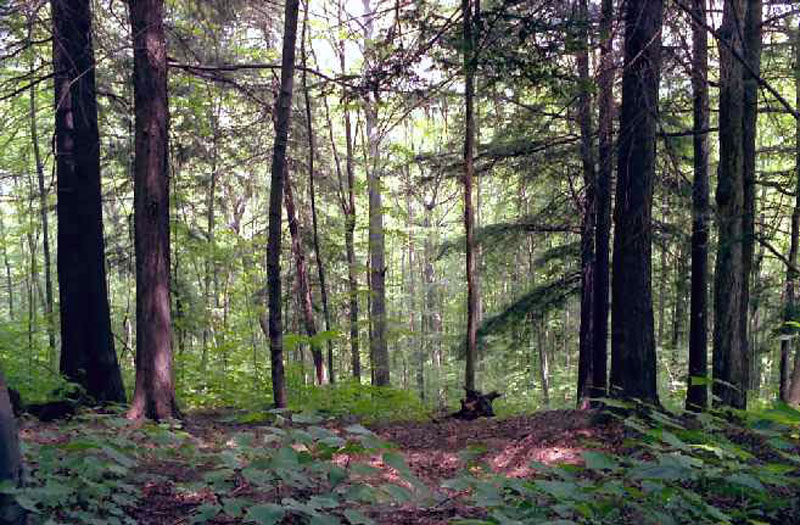
I have one special path to the top that is not worn into a trail. I follow the lower path (19) to where it met the upper path and then proceed straight up. Halfway to the top of the hill, there is a level spot in some hemlocks, where I can sit and look downhill (7). It is so nice to enjoy the silence in the trees. Sometimes I just sit here and look and listen.
I find that the longer I remain in one place, the more things I begin to notice, reinforcing my earlier observations about passing by too quickly. I am interested in identifying the various trees. In the foreground are young striped maples that get their name from the light stripes on the trunks of older ones. The leaves are inordinately large for such small trees. On the ground are the small cones and needles from the nearby hemlocks on either side of the picture. The trees are very tall here and only a minor splash of sunlight filters through.
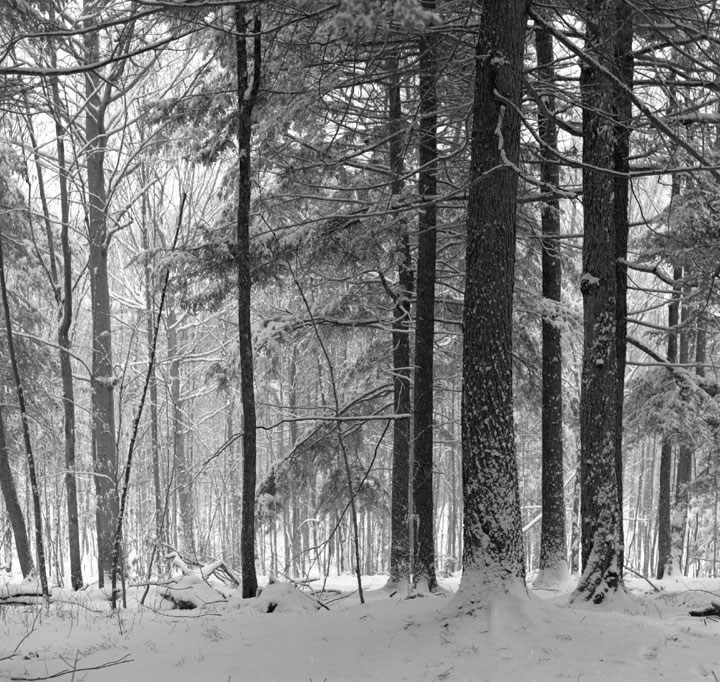
In winter, this favorite spot (7) looking downhill is also changed. I like some of my pictures in black & white because most of the scenes in winter have no color to speak of anyway. However, the hemlocks in the foreground that I know so well retain their green needles throughout the winter. I took this picture with my newly-acquired Hasselblad camera this winter and am anxious to try it out along with a spot meter and the zone system of exposure.
Going uphill to get here is tougher in the snow and I usually do not get as far during my lunch time as I can during the rest of the year. From this point, even without leaves on the trees, as far as I can see in any direction is all part of my woods. A little ways to the south about this high above the lower path, there is a tree with wooden boards nailed to it forming a ladder (13). The boards are partly rotted and the nails are rusted so they must have been there for a long time. A little further on, there is a shallow dug-out area (15) that reminds me like it can be used by kids as a fort. It also offers a good view of the hillside below but looks like it has not been used in a long time. A ground hog lives near the top of the woods. His hole is right by the path. I never see him but in the summer I often see fresh dirt near his hole.
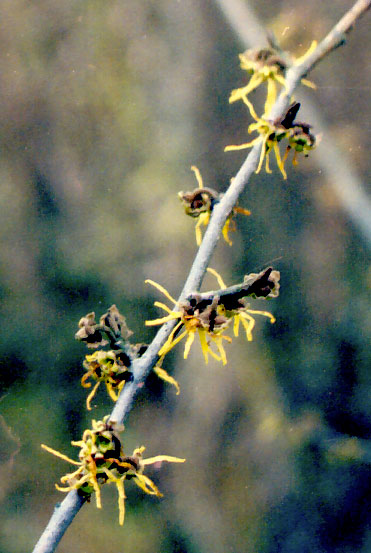
Another tree I do not find in my woods is the Witch Hazel tree. I did find some in a swampy area below my Conklin house. I had no idea what this was when I first saw it. It was blooming in November, which is unusual in itself. Even more surprising is to find that the branches are used as divining rods to supposedly locate underground water. The aromatic extract of leaves, bark and branches is used to relieve minor skin irritations.
Birds
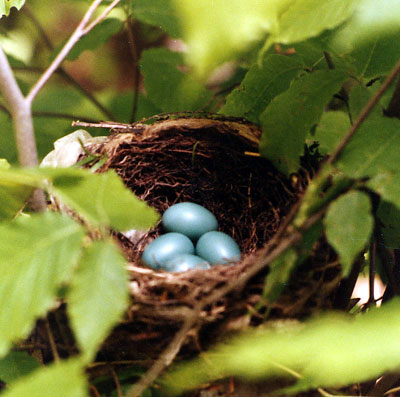 I never waited to see what bird owned these eggs. It
is probably a robin but I am hoping it is a wood thrush. I remembe that
beautiful song that they often sing late in the day. I know it so well because
when I was little, a family of them always nested near our house.
I never waited to see what bird owned these eggs. It
is probably a robin but I am hoping it is a wood thrush. I remembe that
beautiful song that they often sing late in the day. I know it so well because
when I was little, a family of them always nested near our house.
There are many other birds in the area such as the woods peewee, great crested flycatcher, rufous-sided towhee, blue jay, crow, purple finch, chickadee, junco, titmouse and others. I don’t see them very often but can hear them.
One day, as I am walking along the lower path (19), I feel like I am being watched. I look up in a tree and there are a couple of young owls looking at me. That day I didn’t have my camera with me. A few times, if I was looking in the right direction, I could see a large owl flying silently away from me. They are a surprisingly large bird.
A few times, I find a fresh hole in a large healthy tree. Large splinters are torn out and piled up on the ground beneath the tree. This certainly looks like some kind of vandalism. I finally locat the cause one day. It is a large pileated woodpecker. This strikes me as being the industrial grade version of the smaller downy woodpecker that I often see.
The Creek
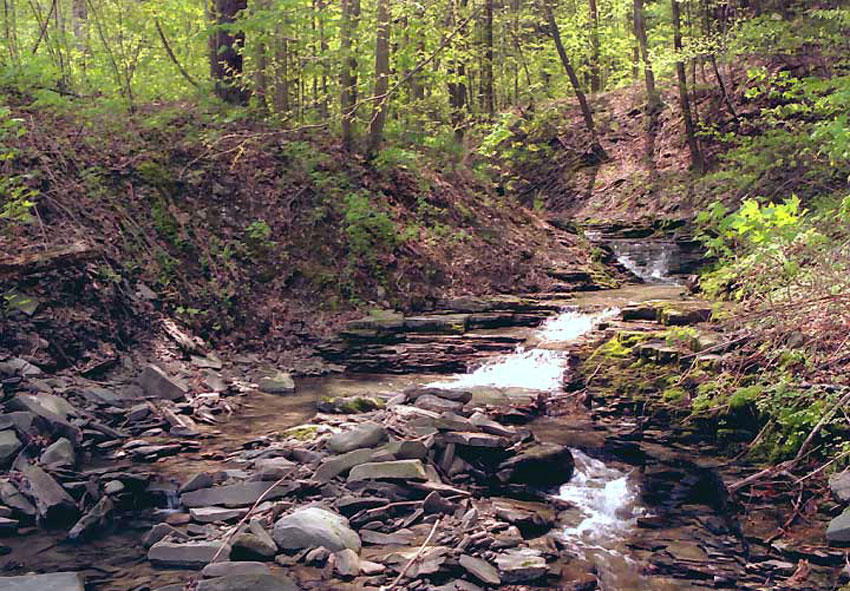
Some days I follow only the creek. In the summer the trees shade the creek. There is normally only a quiet trickle of cool clear water. The flat gray slate-like rocks are clean and easy to walk or sit on. There are occasional pools that have to be walked around. If the sides of the creek are steep, I have to climb up on level ground to get around the pool (10). There are also small water cascades. The creek defines one boundary of the woods and runs way up Felters hill.
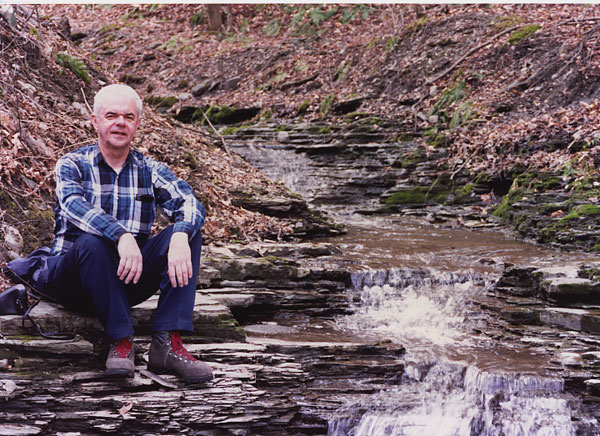
In the summer, cool moist air travels down the ravine where the creek is. It has the wonderful smell of woods. Again, I feel the magic of the soft-lighted afternoons. Perhaps it is a lingering memory of those hazy days when I was a boy and there were no worries or things that must be done. Perhaps it was the excitement and energy of past youth where the whole world seemed new and undiscovered. I am free to observe and learn, with what seems like all the time in the world. I think if I had only one wish it would be for time—all the time to do all there is to do and learn all there is to learn.
In my senior years, I can accept that I will never be able to do or learn everything but am happy to have experienced at least some things and remain in reasonably good health. It reminds me of sayings that there can be no good unless there is also bad or there can be no light unless there is also dark. Maybe comparisons are our way of perceiving—Yin and Yang. In practice, of course, I think there is not just one or the other but all degrees in between.
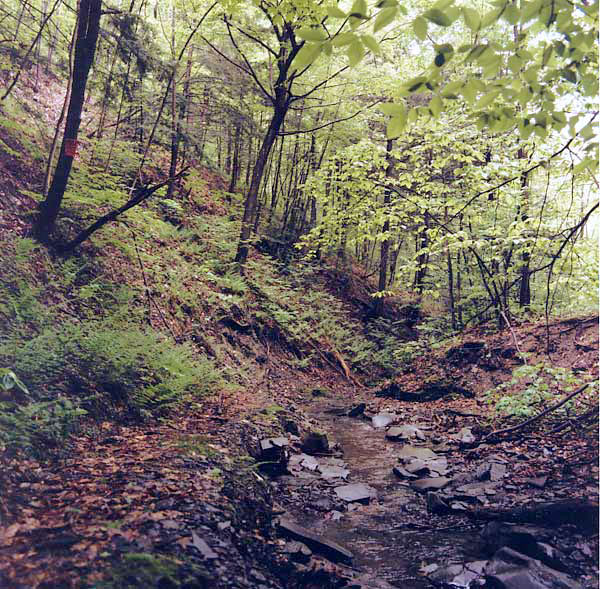
Getting back to the creek, this is a view looking back from further upstream. It is like a conquest, walking up the creek and being able to negotiate obstacles as they appear along the way. Here, is the steepest part of the ravine. It is too steep to climb easily and the leaves are slippery plus there are few trees to hold onto for support. The lower path is very high above the creek at the upper left part of the picture.
I often wonder how long it takes for a stone to travel down the creek. The stones are almost always in the same place all summer and winter and don’t just creep a little at a time. It seems that changes take place with catastrophes like other events in nature. In the spring, if there is a big snowmelt and rain, the creek becomes a raging torrent. It can be so strong that I would not dare to walk across. Large stones can be heard and seen tumbling and shifting in the brown muddy water. After the water subsides drastic changes can be found. Stones, branches and sand are shifted downstream. Old dams of sticks, leaves and stones are gone and new dams are formed in new places. New fossils and interesting stones are exposed. Sometimes a dirt bank has collapsed and been partly washed away.
After setting down these thoughts, I later find in my complete book of poems by Robert Frost that he had put a similar experience into an excellent verse.
|
One Step Backward Taken |

There are many unusually shaped rocks in the creek. One day I find this interesting stone measuring about 8” by 10” and 3” thick. In the center is a rounded red stone about 6" across embedded in the gray slate-like stone. The front face of the red stone is exposed, just as I found it. The back is all gray indicating that the red stone is very thin. I have coated this with shellac to make the color more visible To this day I don't know how it was formed. Of course, a rare find like this ccan not be left there. After carrying it for about 1000 feet down the length of the creek bed, I am very curious to find out how much it weighs. It became very heavy and my arms were sore the next day. It is 17 lbs. on the bathroom scale, a reminder about not being overweight.
A geologist at Cortland suggests the red stone may have been formed by an air pocket that later filled with red sediment. That's probably more believable than thinking someone or something threw it there in the prehistoric mud. Of course, it may have just fallen in the ancient sediment and then covered by more sediment later on.

In the fall, many different colored leaves lay in the creek. They become lodged in the steps of the shale waterfall (11) until they are washed down and pile up against obstructions or lay at the bottom of the pools with their color still showing.
Up further along the creek there is a pine tree that has fallen across (12). The branches almost block the way but I can get under the trunk by pushing a branch or two out of the way.
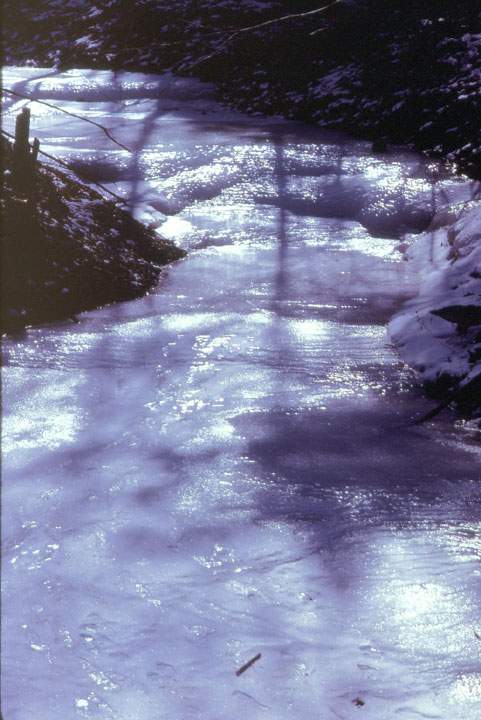
Sometimes, in the winter when it is very cold and there has not been any snow, water flows on top of the ice and becomes frozen, building the ice higher and higher. It can be several feet thick in places. Occasionally, a leaf can be seen imbedded below the surface of the ice, preserved there until the first melt. The stream of ice is like a miniature glacier that flows imperceptibly down a mountain ravine. I suppose, given enough time and cold weather, this ice might actually flow like a glacier. Eventually the water finds a way to flow underneath the ice and it can sometimes be heard gurgling but not seen.
It makes me think of one of my favorite symphonies, Sinfonia Antartica by Ralph Vaughn Williams. I first acquired this back in 1954 when Sir John Gielgud narrated the text:
Ye
ice falls! Ye that from the mountain's brow. Adown enormous ravines slope amain.
Torrents, methinks, that heard a mighty voice,
And stopped at once amid their maddest plunge!
/ Motionless torrents! Silent cataracts!
The Fossils
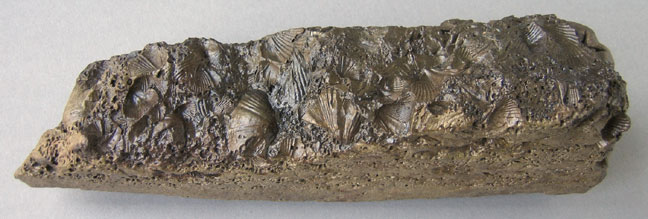
Fossils can be found lying on the ground anywhere in the woods but the creek is the best place to find them. This 12” long specimen was near the lower path. I wondered how long it had been there and where it had come from, perhaps from further up the hill. The sides look like they had almost been cut with a diamond saw. It is also too good to just leave there. I also coated this with shellac. In addition, I found two slabs that are about a square foot in size and 2-3” thick. These are also very heavy.

The presence of fossils indicates that this area was once under water and perhaps from an ancient sea bed extending from the Mississippian to Permian age and as old as 345 million years. Most of the fossils are brachiopods and crinoid stems. The little serrated disc fossils had me puzzled for a while until I learned they are part of a crinoid, and invertebrate animal. The stem of this plant is made of these discs which are stacked one above the other. When the plant dies, the discs all separate.

Flat stones several feet across having wave marks are also very easy to find and form part of the creek bed.
Beyond my Hill
If you follow the upper path (24) to the west, past the property line, it eventually leads you to the home of Dave Sanford. He owns the property next to me. Dave had contacted me because he found the woods had been sold to me and was probably concerned about who I was and what I planned to do with the property. I reassurhim that I plan to keep it as it is and make no changes. I show him one of the large prints I had made from a picture I had taken earlier.
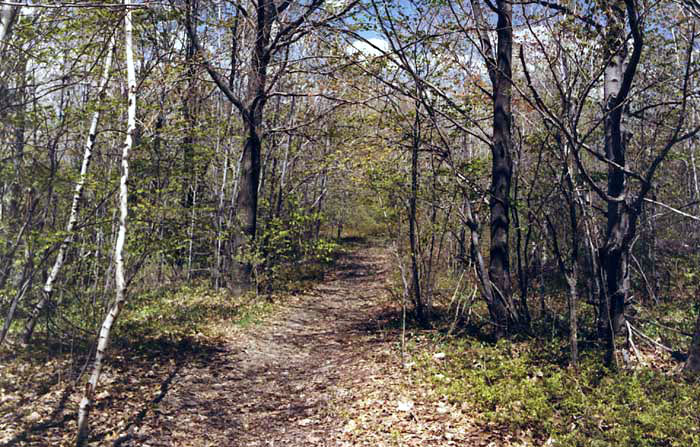
My walk usually doesn’t stop at the top of the hill where the property ends. From there I can go forward to a worn path and then turn south toward the power line (28). One year it was along this path where I saw that a pair of Roufus Sided Towhees had a made nest. The male looks something like a robin but is black as well as red and white. They have a wonderful call that I know from many years ago in the woods at Cape Cod.
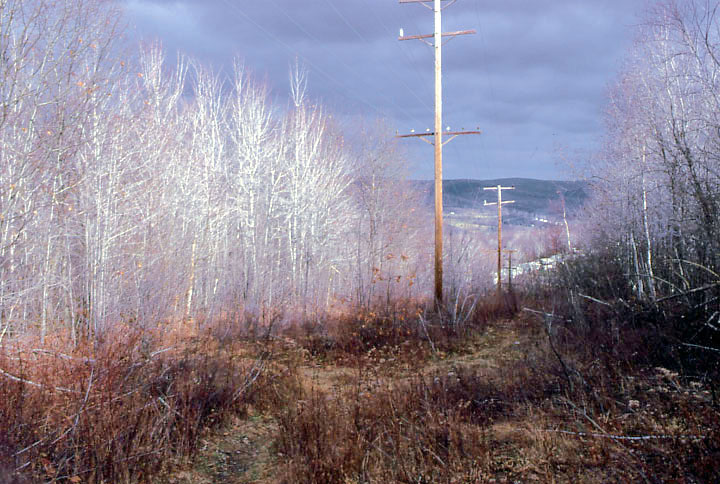
The power line (28) is the limit of the woods that is on the left side of the picture. The line runs down the hill and across Felters road. The brush and trees have been cut down to keep them away from the lines and also perhaps to reduce the risk of fire damage. One day, I notice a line had come loose from an insulator I wrote down the pole number. I called the power company and in a few months they came out and replaced all of the insulators and fixed the loose line. I learn that the line had been installed in 1926 and needed to be reworked. To my surprise and excitement, they left the old insulators on the ground. Being a devoted insulator collector, I am able to find several undamaged ones. These are the large brown ceramic type. They were replaced with smaller gray ceramic ones.
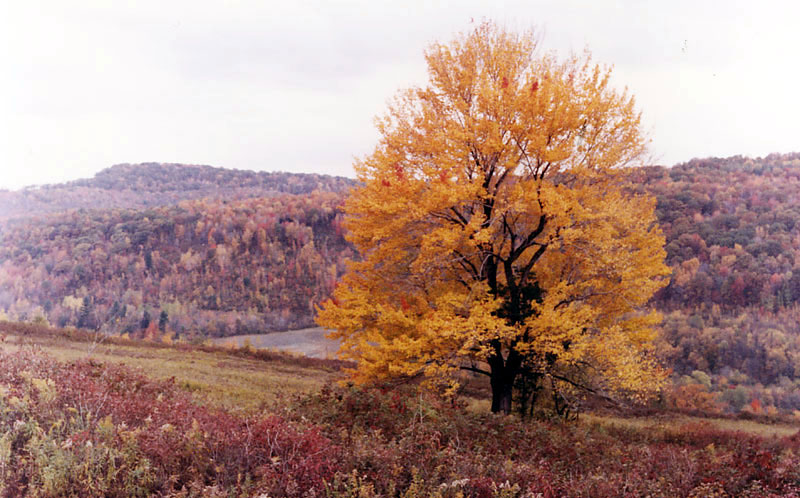
If I continue west along the power lines over the top of the hill, there is an open field. At the bottom of the hill Powers Road merges with Burr Avenue. I usually don’t walk further through this field because there is a better path back a ways that leads toward the south through Miller’s farm and the top of Felter’s Hill.

This is the usual path leading south to a large field that I call the first field. There is a path that circles completely around the field. It has not been mowed in several years and many briers have begun to take over.
After entering into this field, I become very aware of being out in the open and it seems that I am much closer to the clouds, when there are some to see. It is because the land was so much higher here. Some days the sky is very dark and there is often a warm wind indicates that the weather might be going to change. After a new weather front comes through, smaller fast-moving clouds can often be seen.
It is usually very still out in the field. The only sound I can hear is very familiar. I remember this from my days as a boy in Rumford, RI. There is a dull roar and there is a definite direction where the sound comes from. It comes from the direction of Binghamton. It is the cumulative sound of cars and trucks and other noises of the city. It is continuous and muffled here up on the hill. The noise increases during the busy times of traffic as would be expected.
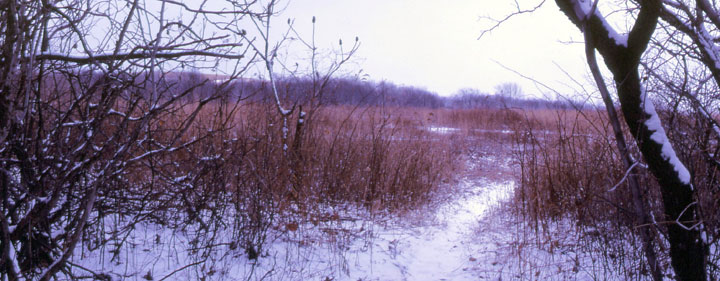
In the winter, the grass and weed growth has subsided. The dead stalks eventually get covered with snow and bend to the ground making hiding places for mice and other small animals. I no longer need to poke around ahead of me with a walking stick to get rid of spider webs strung across the path.
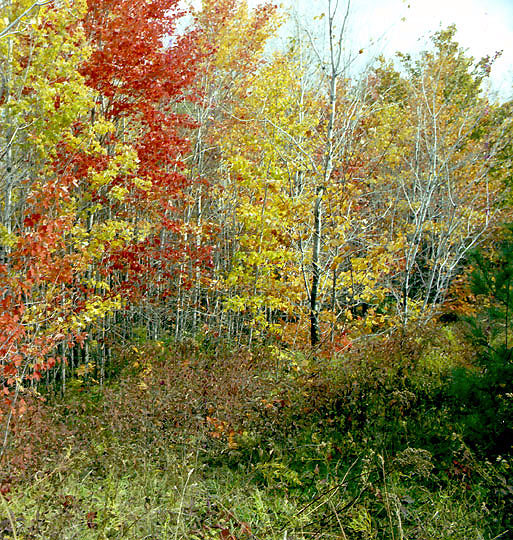
The fall is my favorite time of the year. The time of growing is over and preparations are at hand for the long winter. The foliage in the Binghamton area is spectacular but only lasts for a week or two at the most. In my walks around the first field, there are many colorful trees to see and photograph.
In the fall and the spring, I can hear the geese honking overhead. When I hear them, I can look up and there is the familiar V formation. Sometimes there are several separate formations at one time. If an airplane flies near headed for the county airport on a hilltop a few miles away, they change course temporarily but then change back to their original direction after it has passed.

Very early in the spring, when trudging around in the snow in the first field, I search for pussy willows that might have opened. They are soft and furry to the touch like a kitten’s fur. If they are open, I take one or two twigs and bring them back to the lab to show that spring is on the way and that the cold winter is near to an end. Of course, I am also listening for the first sounds of robins—another harbinger of spring
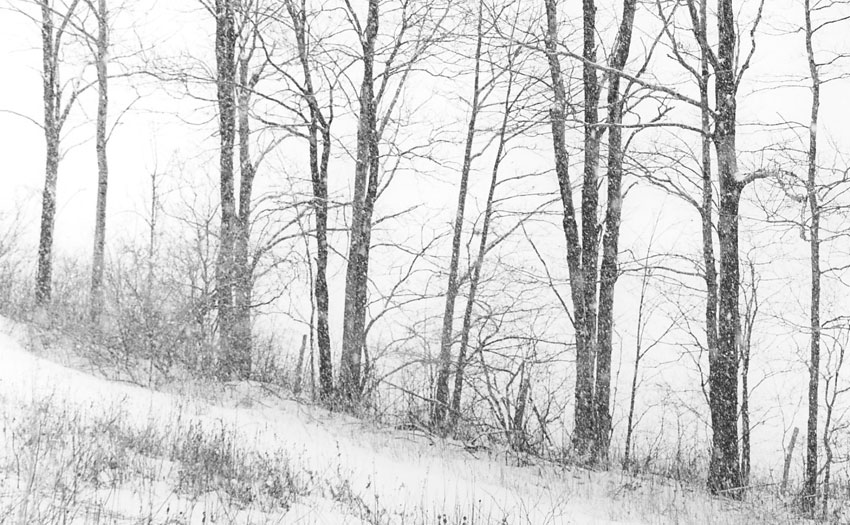
At the end of the first field, the ground slopes downwards. There is a line of trees and then there is a second field. It is snowing so hard in this black & white picture that the second field cannot even be seen. I love to walk out in the open fields when it was snowing. Of course, the timing has to be right so it will be snowing there during my lunch time.

The second field is better kept than the first and is free of many of the briers and weeds. It is mowed each year in the late summer for the hay. This belongs to the Millers whose farm is on the far side and down below on Powers Road.

A second walk is to the end of the upper path to the power lines (18) and then it goes uphill. It is an open area under the power lines and has become congested in some areas with blackberry bushes and their associated thorns. There is no path here. It is very steep and I have to go very slowly. That brings me to where the first route took me but there is a lower path I can also take into the woods to the south. I think this property is also owned by the Millers. I pass an old junk pile of rusted cans and unusual bottles, etc. Occasionally I find an unbroken jar or colored bottle. Many appear to be from the 1940’s or thereabouts. There is a path that leads up almost to the far end of first field but I usually continue on through woods that have older trees but little underbrush, making it a very open area. In the spring, the ground is very wet and I have to choose the route carefully. I eventually come out at the far end of the second field.

Here is the second field where the hay had been mowed. In the distance behind the line of trees is the first field. The second field stays greener than the first field, even in the late fall probably because of the mowing.
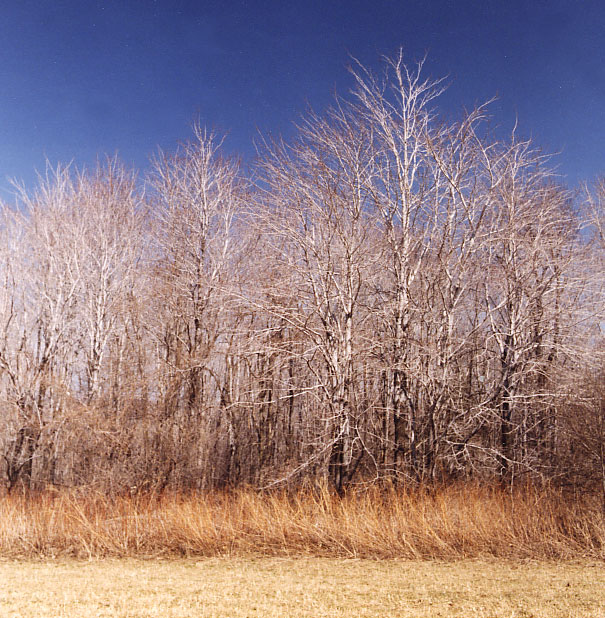
I see another interesting scene when looking east at the edge of the second field. On a clear cold day like this in March, the sun is very bright and the sky is a deep blue. At this time of year there is enough warmth from the sun for lighter clothing.
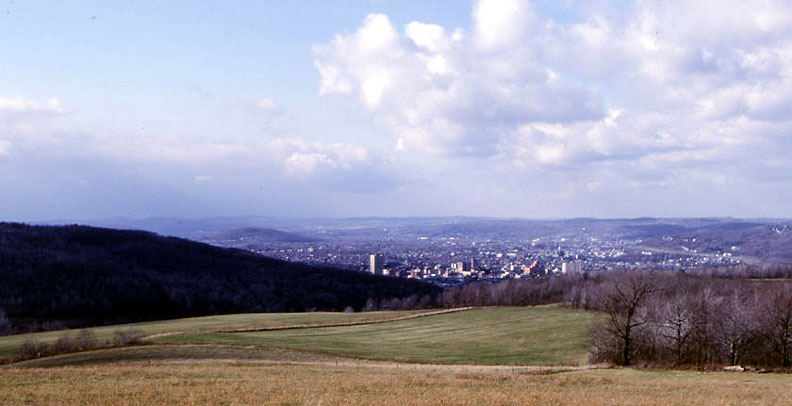
After continuing on past the second field, there is a dirt road that goes uphill to an area where I can look back and see the much of the city of Binghamton and way in the distance is Endicott. It is one of those fall afternoons when it is too nice to be inside working. Reluctantly, I have to start back but I intend to return more often for more pictures.
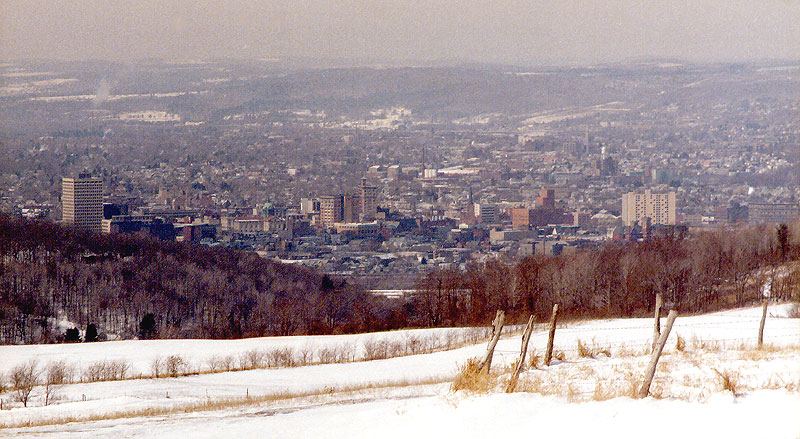
Later, on a cold day, I do return. There is still a haze in the distance that often accompanies a recent snowfall. This time I am higher on the hill at Miller’s farm and thought a telephoto shot would be more interesting,
Plant 4, where I work, is 880 feet above sea level. The top of my property is at 1250 feet, making a climb of 370 feet. The next pictures is taken at about 1400 feet.
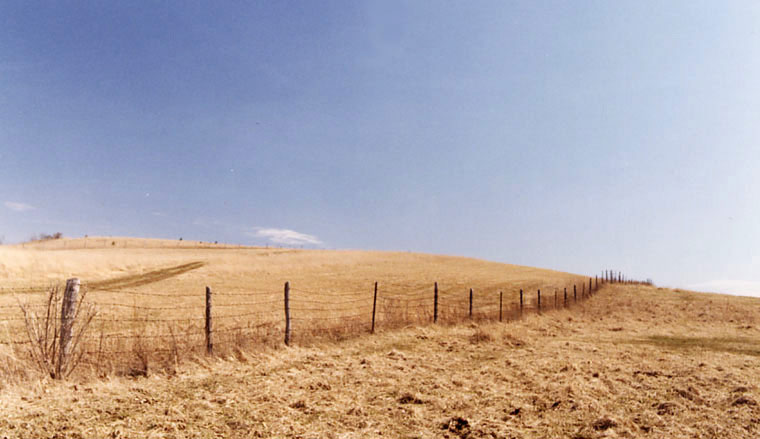
The real top of Felters hill with a few trees on it is far away in the distance at the left and is at 1597 feet. This is another one of those bright sunny days in the fall. There is nothing above me here but the sky and wide open spaces. One day in the summer, I saw a fox pouncing in the grass here. He was probably after a mouse that was trying to hide.
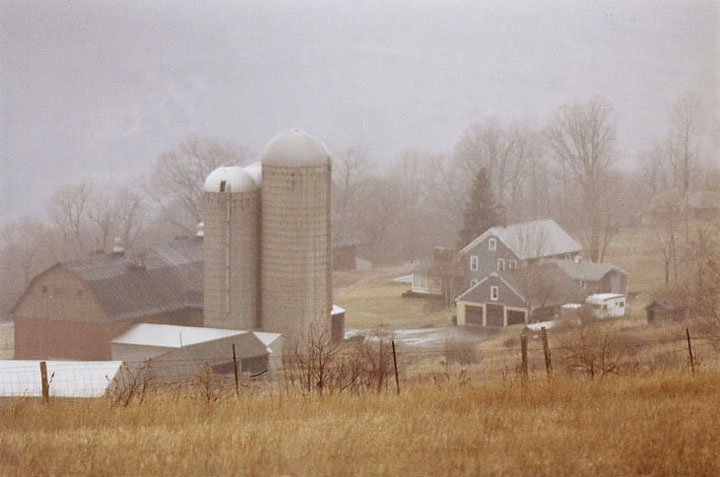
One Saturday in 1981, I am up on Miller’s hill, when it is raining, and take this picture. The farm is owned by Fran Vaughn’s aunt and is still in operation then. There aren’t many people who go out walking in the rain. Again, I am reminded that we have been told by those on the radio and tv that this is not nice weather and we should not like it. It is supposed to be bad, depressing and ugly. However, I think it is very satisfying to experience and see what everything is like when it is all wet and the water drips from places that you otherwise might never know about. The colors are different also. With the mist that hangs in the air, plus the rain, visibility is very limited and the hill behind the trees cannot even be seen.
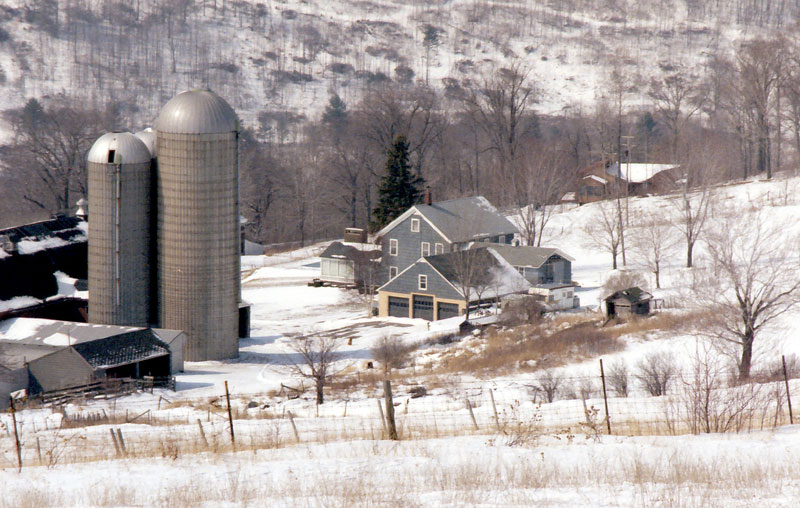
The mood changes drastically, when it gets below zero at night and is only in the single digits in the daytime. Then, there is the wind that blows out of the northwest after a front with snow has passed over. It stays so cold all day that the snow doesn’t even melt in the sunshine.
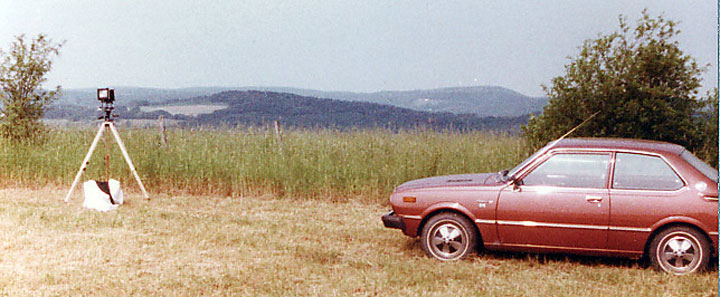
A couple of times I drive up to the top of Felter’s hill and then onto a dirt road that leads to the top of Miller’s hill. Here I am with my Zone VI Sinar monorail 4X5 camera and Zone VI tripod. All of this equipment is too heavy to carry all the way through the woods and up to the top.
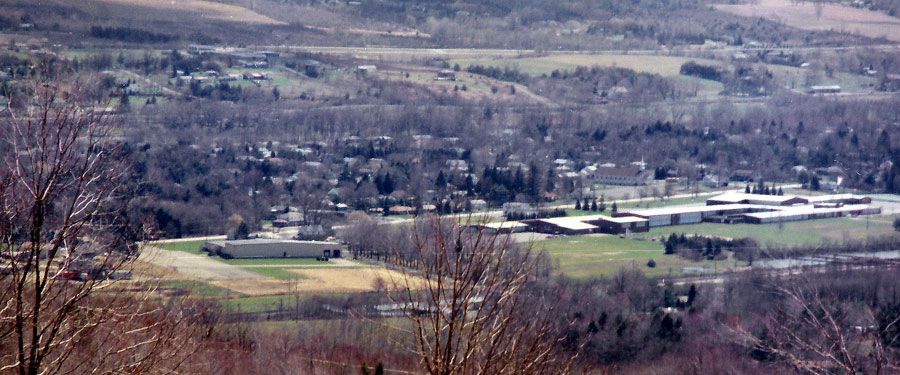
From the top of Miller’s hill, I can look far away to the south and see all of Conklin in the distance. Here is a portion of it using a telephoto lens. At the right, the large group of buildings is the Susquehanna Valley School. At the left is the old McIntosh plant #7 that had been sold in 1984. Shaw road is just to the right of it. Conklin Road runs diagonally across the picture. The Susquehanna River runs above that but is hidden by the trees. Interstate 81 runs across near the top of the picture. Most of the houses on the far side of Conklin road were flooded by the Susquehanna River in 2006. The flood did not reach the school or Plant 7 that are on the near side.
This is the end of my journey to the top of Felters Hill. It all started from wanting to escape from the lab at lunch time. As I gradually explore higher up on the hill and beyond, I find even more interesting places. There is no end to the different routes that I can take in my explorations and I never feel that I can get lost. Sometimes I take a random walk through the upper woods and eventually come out to a place I recognize.
The experience is a wonderful time in my life when I am doing work that I have always wanted to do and at the same time combine it with my love of photography and nature. I took hundreds of pictures and these are only a few that I have used to illustrate my adventures. I hope that others can relate to what I have tried to describe.
I plan to write a sequel about my earlier noontime adventures when I am working at plant 5 in Hillcrest. There is the field behind the building, a woods further to the south, the Chenango River and an old farm house across the Brandywine Highway.
Map of the Woods
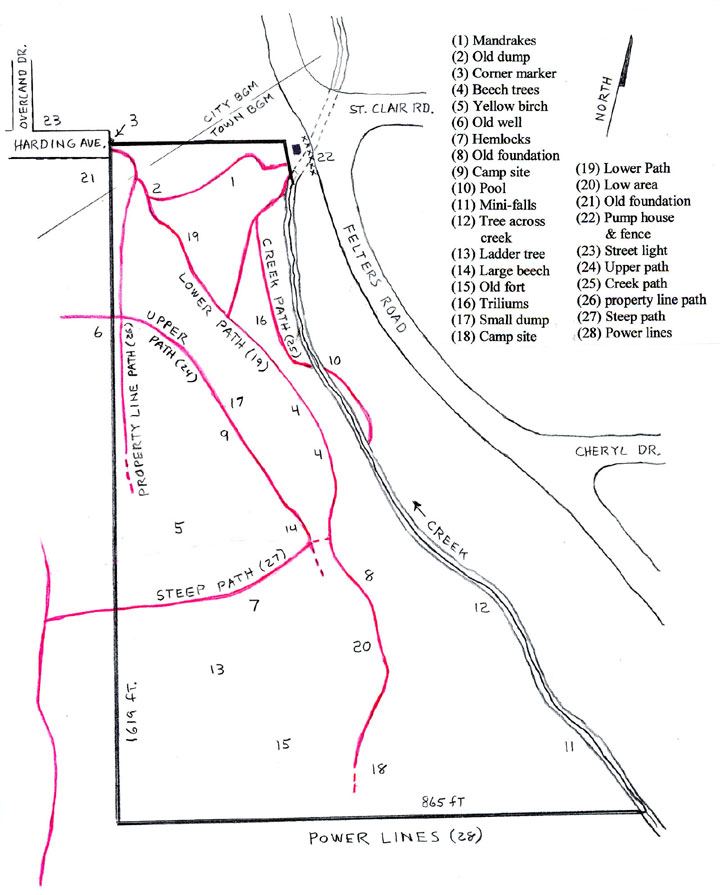
List of Locations
Woods Update 2013

View of the main plant with the new front appearance. Plant 4 is to the right and my woods is on the hill beyond in the center.
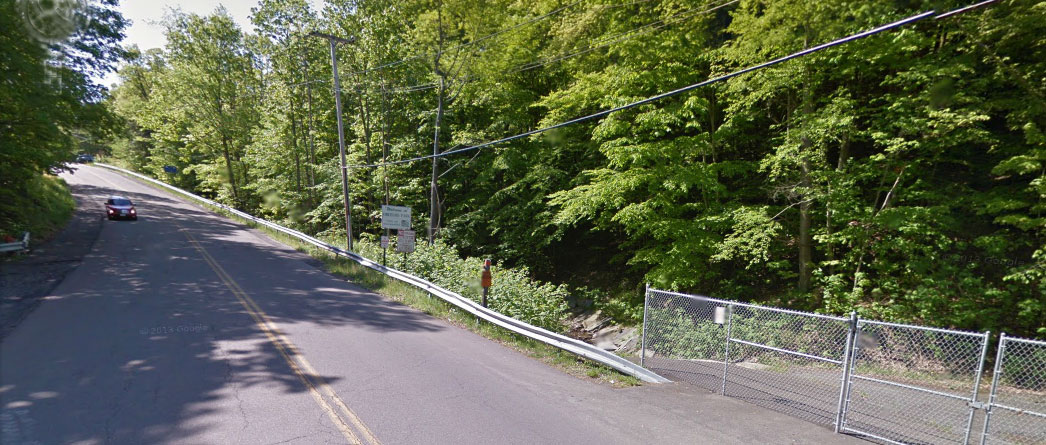
The entrance
is at the junction of the guard rail and the chain link fence. You can see a
few rocks that are in the creek.
All of the trees have gotten bigger in the past 20 years.
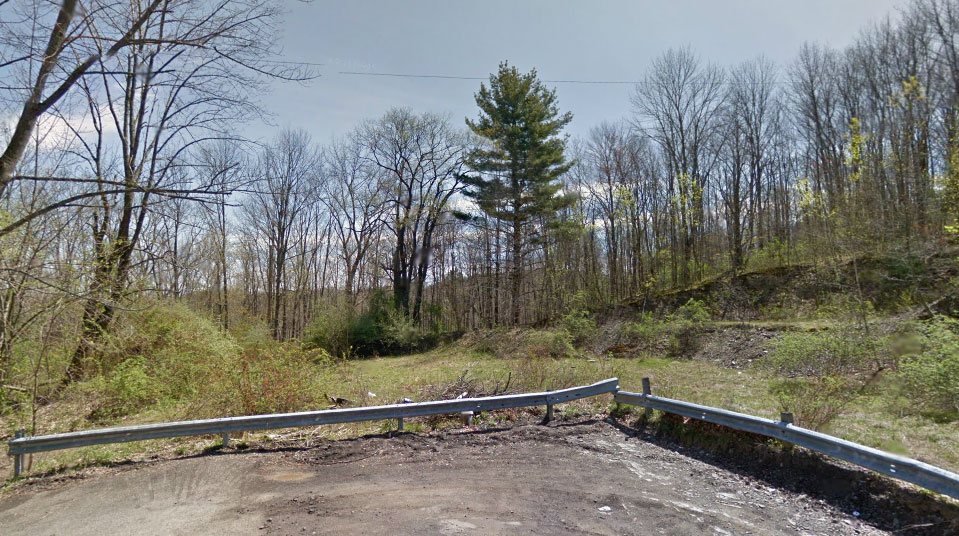
Early
spring 2013 is here at the corner of Overland Drive and Harding. The guard
rails are still there and dumping of trash is still eliminated.
The entrance to High Acres is still protected.
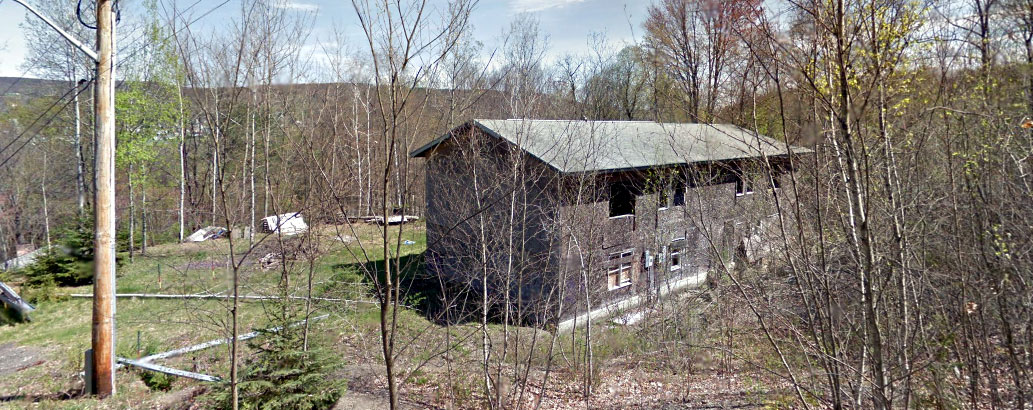
The proposed apartment building is still unfinished. It has been there almost 25 years now.
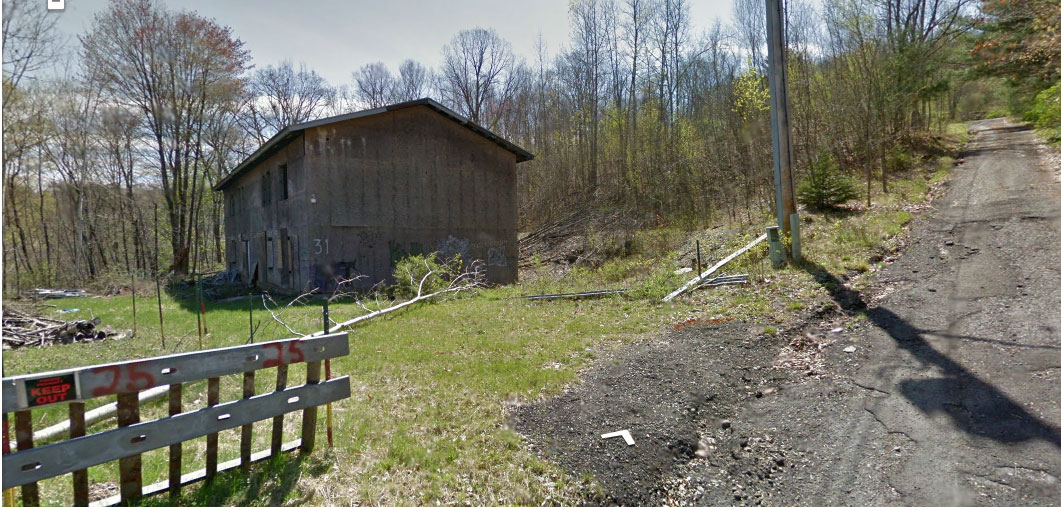
Now there is a Keep Out sign posted. Somebody lost a lot of money. Overland drive is still a very steep hill.
|
About This Site |
||
|
|
More
text and pictures will be added as my research continues. |
|
|
|
Created
by Roger Russell |
|


